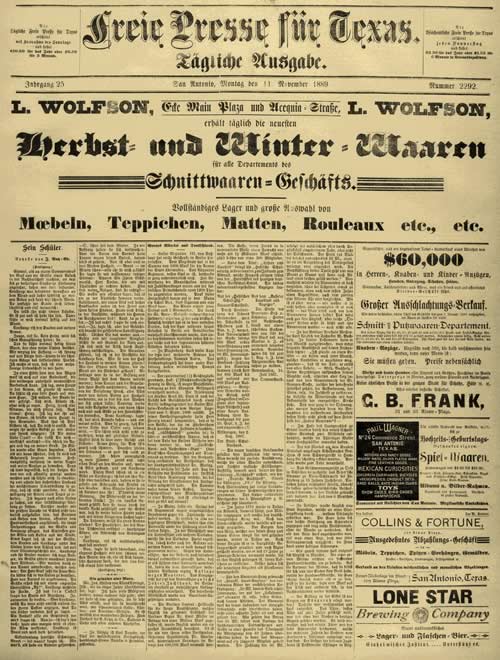Books by
Michael Barr
Order Here: |
|
August
Siemering's ringing abolitionist editorials are considered classics
in German-American literature. He was a teacher, editor and soldier.
He was a schriftsteller (writer) "of no small merit," and by all accounts
a pretty good dancer.
A free-thinker and political liberal, Siemering came to Texas from
his home in Germany in 1851. He was among the first of the Forty-Eighters
to settle in Sisterdale.
The Forty-Eighters supported the democratic revolution that swept
across Europe in the 1840s. But the revolution failed, leaving the
Forty-Eighters between a rock and a hard place.
About 4,000 Forty-Eighters came to the United States. About 100 came
to Texas. Most of them, including August Siemering, settled in Sisterdale.
Joining him were such notables as Otto von Behr - the son of a German
prime minister, Carl Daniel Adolph Douai - the man who introduced
the kindergarten system to the U.S. and Edgar Gerhard Julius Ludwig
von Westphalen - the son of a Prussian Baron and Karl Marx's brother-in-law.
The Forty-Eighters made Sisterdale
one of the most unusual outposts on the Texas frontier. Sisterdalians
were not rugged frontier types but urban, cosmopolitan intellectuals.
They read the best literature and spent hours discussing Voltaire,
Kant and Hegel. They conducted town meetings in Latin or Greek. They
were the most educated and enlightened people of their day.
Not known for laying low and keeping quiet, the Forty-Eighters were
soon up to their eyeballs in a new controversy - slavery.
In 1853 August Siemering began contributing articles to a German language,
anti-slavery publication called the San Antonio Zeitung ("newspaper"
in German). That same year the abolitionist organization Die Freie
Verein (The Free Society) elected him secretary.
In May 1854 the Verein called a meeting of German abolitionists in
conjunction with the Staats-Saengerfest (State Singing Festival) in
San Antonio.
The meeting produced a platform that included equal pay for equal
work, direct election of the president, abolition of capital punishment,
abolition of slavery, free schools including universities and total
separation of church and state.
The platform was controversial to say the least. Even German conservatives
opposed it.
In
1856 August Siemering moved to Gillespie
County. He opened the first public school in Fredericksburg.
The school received permission to meet in a room at the courthouse
"provided that the same shall be vacated during the holding of District
Court."
He married Clara Schuetze of Gillespie
County in 1859.
Evidence suggests he was a persuasive man. Members of the Gillespie
County Rifles, a company of Confederates led by Capt. Charles H. Nimitz,
identified him as a Unionist, but after meeting with Siemering the
group removed his name from the list of targeted individuals.
Although an abolitionist he was drafted into the Confederate army
in 1861. He served in Company E, First Texas Cavalry, led by Capt.
Frank van der Stucken. Three years later he resigned his commission
as a lieutenant citing myopia and general bad health. He referred
to his war experience as a "nightmare."
In 1864 he moved to San
Antonio where he taught at a military school. At night he taught
ballroom dancing. |
 |
|
Freie Presse
fur Texas (Texas Free Press)
Clcick on image to enlarge
|
In 1865 Siemering
established a German language newspaper called Freie Presse fur
Texas (Texas Free Press). The Freie Presse served a growing
population of German speakers in San
Antonio and the Hill
Country. That same year Siemering established the San Antonio
Express. Today as the Express-News, it is the 4th largest
newspaper by circulation in Texas.
August Siemering had the skill and the personality to operate successfully
in those difficult times. He was said to be smooth and cordial but
direct in his relationships. He spoke "straight from the shoulder."
He impressed people, even those who didn't like him. Unlike some of
the other Forty-Eighters, he had the ability to get along with people
with whom he disagreed.
At his death at age 55 a friend described him as a believer in no
diety "but he was one of those cosmopolitans whose hearts are in the
right place, whatever may be their religion, and who will always be
found on the side of the weak and the oppressed." |
Sources:
"the first city public school," Fredericksburg Standard, April
26, 1967.
"Telegraphic," Galveston Flake's Daily Bulletin, February 18,
1870.
"Summary of the Latest News," Colorado Citizen, June 12, 1884.
Richard L. Puglisi Jr., "Bexas County Chief Justice August Siemering
," Journal of the Life and Culture of San Antonio, University
of the Incarnate Word.
"Judge Seimering seriously ill," San Antonio Light, September
15, 1883.
"Siemering Dead," San Antonio Light, September 20, 1883.
|
|
|
